동사 3 단 변화
한국어 동사는 행위, 상태, 사건 등을 표현하는 역할을 합니다. 한국어 동사의 3 단 변화는 동사의 활용 형태 중 하나로, 동사의 종성을 변화시켜 문법적인 기능을 달성하는 것을 의미합니다. 3 단 변화는 한국어 문법에서 중요한 부분을 차지하며, 한국어 학습자들은 3 단 변화를 잘 이해하고 활용할 필요가 있습니다.
1. 3 단 변화의 개요 및 의미
동사의 3 단 변화는 일반적으로 종성의 변화로 이루어집니다. 종성의 변화는 문법적인 기능을 수행하며, 동사와 함께 사용될 때 문장의 표현력을 향상시킵니다. 3 단 변화의 주된 목적은 문법적인 표현을 위해 동사와 어울리는 형식으로 동사의 종성을 변화시키는 것입니다.
2. 예시와 함께 3 단 변화의 기본 규칙 소개하기
동사의 3 단 변화는 명확한 규칙과 패턴을 따릅니다. 가장 일반적인 3 단 변화의 규칙은 “ㅂ”, “으” 그리고 “으시” 형식을 따르는 것입니다. 예를 들어, 동사 “가”의 3 단 변화는 다음과 같이 변합니다:
– 기본형: 가
– 3 단 변화: 갑니다
이 규칙은 대부분의 동사에 적용됩니다. 하지만, 몇 가지 불규칙한 변화를 가지는 동사들도 존재합니다.
3. 불규칙 변화를 가지는 3 단 동사들
3 단 변화를 가지는 동사 중 일부는 규칙적인 변화가 아닌 불규칙한 변화를 보입니다. 예를 들어, 동사 “되다”의 3 단 변화는 다음과 같이 변합니다:
– 기본형: 되
– 3 단 변화: 됩니다
또 다른 불규칙한 변화를 보이는 동사로는 “이루어지다”, “가지다”, “잡히다” 등이 있습니다. 이러한 불규칙한 변화는 개별 동사마다 다르며, 외우고 숙지해야 합니다.
4. 3 단 변화에서의 불규칙 동사 예외 처리하기
불규칙한 변화를 가지는 동사들은 따로 외워야 하지만, 이러한 예외적인 변화들에 대한 이해와 패턴을 파악하는 것은 중요합니다. 이를 통해 불규칙한 변화들도 자연스럽게 활용할 수 있습니다. 또한, 불규칙한 변화에 익숙해진다면 새로운 동사들을 보다 쉽게 이해하고 활용할 수 있습니다.
5. 3 단 변화 시 생기는 철자 및 발음의 변화
3 단 변화는 동사의 종성에 따라 철자와 발음에 변화가 생깁니다. “ㅂ” 형식에서 종성으로 인해 “ㅂ”이 “습니다”로 바뀌고, “으” 형식에서는 종성으로 인해 “으”가 “으”로 바뀝니다. 또한, “으시” 형식에서는 종성으로 인해 “으시”가 “으셔”로 변합니다. 이러한 변화는 동사의 철자와 발음을 적절하게 적용하여 사용해야 합니다.
6. 중요한 예시들과 함께 3 단 변화에 대한 심도 있는 이해하기
한국어 동사의 3 단 변화에는 많은 예시가 있습니다. 동사의 3 단 변화를 학습할 때 중요한 동사들을 다루는 것이 도움이 됩니다. 몇 가지 중요한 예시는 다음과 같습니다:
– “동사의 3단변화 정리”는 일반적인 규칙을 따르는 동사들의 3 단 변화를 정리한 것입니다.
– “become 3단변화”의 3 단 변화는 “is”로 변합니다.
– “use 3단변화”의 3 단 변화는 “사용합니다”로 변합니다.
– “find 3단변화”의 3 단 변화는 “찾습니다”로 변합니다.
– “wake 3단 변화”의 3 단 변화는 “일어납니다”로 변합니다.
– “spread 3단변화”의 3 단 변화는 “퍼집니다”로 변합니다.
– “shine 3단변화”의 3 단 변화는 “빛나요”로 변합니다.
– “tear 3단변화”의 3 단 변화는 “찢습니다”로 변합니다.
이러한 예시들을 통해 3 단 변화를 심도 있게 이해할 수 있으며, 동사의 종성을 적절하게 변화시킬 수 있습니다.
FAQs:
Q1: 3 단 변화는 한국어 문법에서 왜 중요한가요?
A1: 3 단 변화는 한국어 문법에서 중요한 부분을 차지하며, 문장의 표현력을 높이는 역할을 합니다. 따라서 3 단 변화를 이해하고 활용하는 것은 한국어 학습에 필수적입니다.
Q2: 어떤 동사가 3 단 변화를 가지나요?
A2: 대부분의 동사들이 3 단 변화를 가지며, 규칙적인 변화를 따르는 동사들도 많이 있습니다. 하지만 일부 동사들은 불규칙한 변화를 보이므로 개별적으로 외워야 합니다.
Q3: 3 단 변화 시 철자와 발음에 어떤 변화가 생기나요?
A3: 3 단 변화 시 동사의 종성에 따라 철자와 발음에 변화가 생깁니다. “ㅂ” 형식은 “ㅂ”이 “습니다”로 변하고, “으” 형식은 “으”가 “으”로 변합니다. “으시” 형식은 “으시”가 “으셔”로 변합니다.
Q4: 3 단 변화를 외우는 법은 무엇인가요?
A4: 3 단 변화를 외우는 가장 좋은 방법은 예시와 함께 빈번하게 사용되는 동사들을 학습하는 것입니다. 이를 통해 3 단 변화의 규칙과 불규칙한 변화를 익혀나갈 수 있습니다.
사용자가 검색한 키워드: 동사 3 단 변화 동사의 3단변화 정리, become 3단변화, use 3단변화, find 3단변화, wake 3단 변화, spread 3단변화, shine 3단변화, tear 3단변화
Categories: Top 70 동사 3 단 변화
동사 3단 변화는 잊고❌ 이렇게 공부하세요! 불규칙동사 ☝️탄
여기에서 자세히 보기: taomalumdongtien.net
동사의 3단변화 정리
한국어 동사의 변화 형태는 매우 중요한 문법 개념입니다. 동사의 3단변화는 동사의 어간이 어떻게 변하는지를 설명하는 규칙입니다. 한국어 문법을 공부하는 데 있어서 동사의 3단변화 정리를 이해하는 것은 필수적입니다. 이 글에서는 동사의 3단변화에 대해 자세히 알아보고, 흔히 묻는 질문에 대한 답을 제시하고자 합니다.
동사의 3단변화란 무엇인가요?
동사의 3단변화는 동사의 어간이 변하는 규칙입니다. 어간은 동사의 핵심이 되는 부분으로, 활용 형태에 따라 변화합니다. 한국어 동사는 일반적으로 어말 세 음절에서 어간을 만들고, 이 어간이 다양한 변화를 겪습니다. 동사의 3단변화로는 불규칙 동사 변화, ㄹ/을 불규칙 변화, 및 용언 어미 붙임 등이 있습니다.
어떻게 동사의 3단변화를 이해할 수 있을까요?
동사의 3단변화를 이해하기 위해서는 동사의 어간을 알아야 합니다. 어간은 동사 원형의 어미를 제거한 형태라고 할 수 있습니다. 어간을 알면, 동사 원형에 어말 음절인 ‘다’를 덧붙여 기본형을 만들 수 있습니다. 다만, 어간의 끝소리가 받침으로 끝날 경우, ‘라’를 붙여 기본형을 만들어야 합니다. 이와 같은 기본형을 통해 다른 활용 형태를 유추할 수 있습니다.
동사의 3단변화의 종류에는 어떤 것들이 있나요?
동사의 3단변화에는 불규칙 동사 변화, ㄹ/을 불규칙 변화, 및 용언 어미 붙임 등이 있습니다.
불규칙 동사 변화는 어간의 중성화 혹은 탈락, 혹은 약화 등으로 인해 어간이 변하는 형태를 의미합니다. 예를 들어, 불규칙 동사 ‘오다’의 어간은 ‘오’이지만, ‘와’로 변화합니다. 이러한 불규칙 동사 변화는 따로 외우고 숙지해야 합니다.
ㄹ/을 불규칙 변화는 어말 음절이 받침 으로 끝날 때 ‘ㄹ’을, 아닐 경우에는 ‘을’을 붙여 변화합니다. 예를 들어, ‘걷다’의 어간 ‘걷’에 ㄹ/을 불규칙 변화를 적용하면 ‘거닐’이 됩니다.
용언 어미 붙임은 동사 어간 뒤에 다양한 어미를 붙여 동사의 형태를 바꾸는 것을 의미합니다. 예를 들어, ‘먹다’의 어간 ‘먹’에 ‘어’ 어미를 붙여 ‘먹어’를 만듭니다. 이러한 용언 어미 붙임은 다양한 문법 규칙을 적용해야 하기 때문에 공부하기가 쉽지 않을 수 있습니다.
자주 묻는 질문
1. 어린이들이 동사의 3단변화를 어떻게 배우면 좋을까요?
어린이들은 언어적인 능력이 빠르게 발달하기 때문에 동사의 3단변화를 잘 습득할 수 있습니다. 이 때 가장 효과적인 방법은 주기적으로 반복하는 것입니다. 동사의 어간에 ㄹ/을 불규칙 변화나 용언 어미 붙임을 적용하는 예시 문제를 풀어보면서 연습하면 도움이 될 것입니다.
2. 불규칙 동사 변화를 외우려면 어떻게 해야 하나요?
불규칙 동사 변화는 예외적인 규칙이기 때문에 외우기가 어려울 수 있습니다. 하지만, 예시 문장을 활용하거나 노래 등을 통해 외워보는 것이 도움이 될 수 있습니다. 반복적인 연습을 통해 불규칙 동사 변화를 습득할 수 있습니다.
3. 동사의 3단변화 외에도 다른 동사 활용 형태가 있나요?
네, 동사의 3단변화 외에도 불규칙 활용 형태, 불규칙 규칙 활용 형태, 간섭 활용 형태 등 다양한 동사 활용 형태가 있습니다. 각각의 활용 형태는 다른 규칙을 따르기 때문에 개별적으로 공부를 해야합니다.
동사의 3단변화 정리는 한국어 학습자들에게 매우 중요한 문법 개념입니다. 동사의 어간이 어떻게 변하는지 이해하면 문법을 올바르게 사용하는데 큰 도움이 됩니다. 주기적인 반복 연습과 다양한 예시를 활용하여 동사의 3단변화를 익혀보세요. 그러면 한국어 실력 향상에 도움이 될 것입니다.
Become 3단변화
What is the 3단변화 in Korean?
The 3단변화, also known as the three-step verb conjugation system, refers to the three different forms a verb takes depending on its stem ending. These three forms are used to represent different tenses, moods, or aspects of the action being described.
Understanding the three steps:
1. The first step is the plain form or “dictionary form” of the verb, which is the original and unchanged form. It mostly ends with “다” and serves as a base for conjugation.
2. The second step involves removing the “다” ending from the plain form, resulting in the verb stem. The stem is then utilized to construct various verb tenses or forms.
3. The third and final step entails attaching the appropriate verb ending, depending on the tense, mood, or aspect you wish to convey. These endings can differ according to the level of politeness, formality, and speech style.
Types of verb bases:
In Korean, the verbs are broadly categorized into three types of verb bases: 아/어, 이, and 으.
1. 아/어 verb bases: These verbs end with 아 or 어 in their plain form. For example, “먹다” (to eat) becomes “먹어” in the verb stem form. To conjugate, you simply add the desired ending after the verb stem, such as “먹어요” (I eat).
2. 이 verb bases: These verbs end with 이 in their plain form. For example, “읽다” (to read) becomes “읽” in the verb stem form. To conjugate, you add the desired ending, but depending on the ending, there may be sound changes in the stem, such as “읽어요” (I read).
3. 으 verb bases: These verbs end with the vowel 으 in their plain form. For example, “춥다” (to be cold) becomes “추” in the verb stem form. However, some 으 verbs undergo sound changes in their stem when followed by certain verb endings. For instance, “추어요” (I am cold) changes to “추워요.”
FAQs about the 3단변화 in Korean:
Q1: Do all verbs in Korean follow the 3단변화 conjugation system?
A1: No, not all verbs in Korean follow this system. Some verbs, known as “irregular verbs,” have unique conjugation patterns that don’t comply with the three-step conjugation. These irregular verbs need to be memorized separately.
Q2: Are there any exceptions or special cases within the 3단변화 system?
A2: Yes, there are a few exceptions to the conjugation rules in certain situations. For instance, when adding the future tense marker “-겠-” to the verb stem, some sound changes occur, such as “가다” (to go) becoming “갈 거예요” (will go).
Q3: How can I improve my mastery of the 3단변화 in Korean?
A3: Practice is key to mastering the 3단변화 system. Regularly engage in conjugation exercises, create sample sentences, and expose yourself to different verb forms to solidify the conjugation rules in your mind. Utilize language learning resources such as textbooks, online courses, and language exchange partners to reinforce your comprehension.
Q4: Can I mix different verb bases in a sentence?
A4: No, it is important to maintain consistency within a sentence. Using different verb bases can result in grammatical errors or make the sentence incomprehensible. Stick to one type of verb base throughout your sentence for clarity.
Q5: Does the 3단변화 system only apply to verbs?
A5: No, the 3단변화 system is primarily focused on verbs, but you can also find similar conjugation patterns in adjectives, as they undergo changes based on tense, politeness level, and sentence structure.
Mastering the 3단변화 system is crucial for fluent Korean communication. Familiarizing yourself with the three-step verb conjugation and understanding the different verb base types will significantly enhance your Korean language skills. Practice consistently, seek additional resources, and don’t be afraid to make mistakes as you embark on this exciting language learning journey.
Use 3단변화
The Korean language has a unique feature known as 3단변화 (3-dan byeonhwa), which refers to the three different forms of conjugation used for verbs and adjectives. The three forms are the plain form (the dictionary form), the polite form, and the honorific form. Understanding and correctly utilizing these forms are essential when learning Korean and communicating effectively in various social contexts. In this article, we will delve into the intricacies of the 3단변화, explore its uses, and provide detailed explanations to help learners master this grammar concept.
1. The Plain Form (Dictionary Form)
The plain form, also known as the dictionary form, is the basic uninflected form of a verb or adjective. This form is used in dictionaries to list the word and its principal meaning. It serves as the foundation for conjugation into the polite and honorific forms. For instance, the verb “to eat” in its plain form is 먹다 (meokda).
2. The Polite Form
The polite form is used in regular communication, especially in informal and semi-formal situations. This form conveys politeness and respect suitable for conversations with acquaintances, friends, and colleagues. The polite form can be created by adding 요 (yo) to the verb stem for verbs, and by adding 습니다 (seumnida) for adjectives. For example, by adding 요 to the verb stem 먹 (meok) from 먹다 (to eat), we have the polite form 먹어요 (meogeoyo).
The polite form can also be further modified by attaching various endings to express different tenses or grammatical nuances. Some common suffixes include -았/었어요 (-at/eosseoyo) for the past tense, -고 싶어요 (-go shipeoyo) to express desires, and -지 않아요 (-ji anayo) for negation.
3. The Honorific Form
The honorific form is employed when speaking to someone of higher social status or showing respect to elders, superiors, or strangers. It is crucial to use this form to maintain appropriate etiquette and demonstrate politeness. Creating the honorific form involves using the subject honorific marker -시 (si) before the verb stem. For instance, 먹다 (to eat) becomes 식사하시다 (siksa hasida) in the honorific form.
It is important to note that some irregular verbs do not follow the regular conjugation rules. Therefore, it is advisable to consult a comprehensive Korean grammar resource to learn the conjugation patterns of these exceptions.
FAQs:
Q1: Can I use the dictionary form in daily conversation?
A1: While using the dictionary form is technically correct, it is considered too direct and blunt for daily conversation. The polite form is highly recommended to maintain a polite and respectful tone when speaking.
Q2: When should I use the honorific form?
A2: The honorific form is essential when addressing people of higher social status or showing respect to elders, superiors, or unfamiliar individuals. It is crucial to demonstrate good manners by using the honorific form in appropriate contexts.
Q3: Are there any exceptions to the conjugation rules?
A3: Yes, some verbs have irregular conjugation patterns. It is recommended to refer to a reliable Korean grammar resource or textbook to learn these exceptions.
Q4: How can I learn the conjugation patterns effectively?
A4: Regular practice, exposure to native Korean materials such as books, movies, and music, and engaging in conversations with native speakers will help solidify your understanding of the conjugation patterns. Additionally, online language learning platforms and Korean language courses often provide interactive exercises and drills to improve your conjugation skills.
Q5: Are there any other conjugation forms besides the three mentioned?
A5: Although the three forms covered in this article are the most common, there are other conjugation forms, such as the formal form used in formal or official settings. However, for everyday conversation, the plain, polite, and honorific forms are sufficient.
In conclusion, mastering the 3단변화 is crucial for effective communication in Korean. Understanding the differences and applications of the plain, polite, and honorific forms allows learners to navigate various social situations and convey politeness and respect. Regular practice and exposure to Korean language resources will facilitate the learning process, enabling learners to become confident and fluent speakers of this beautiful language.
주제와 관련된 이미지 동사 3 단 변화
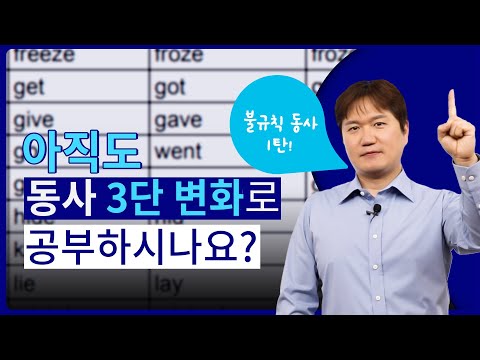
동사 3 단 변화 주제와 관련된 이미지 46개를 찾았습니다.
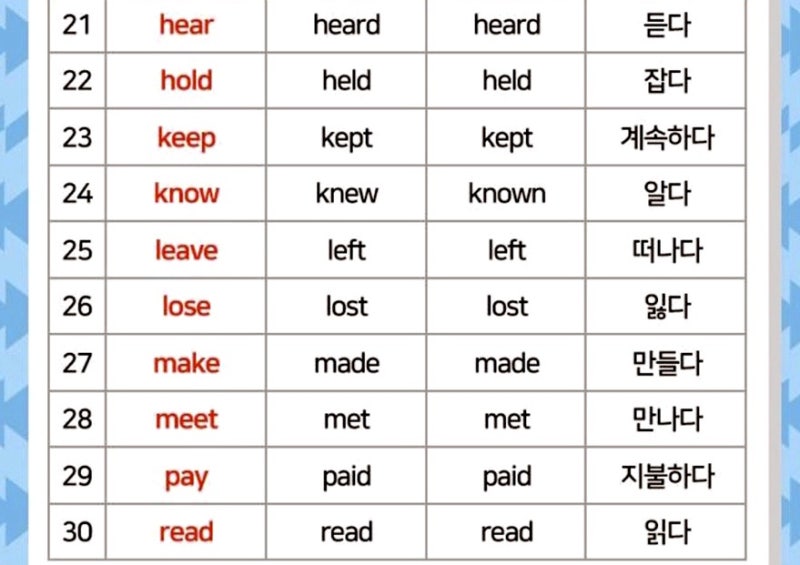

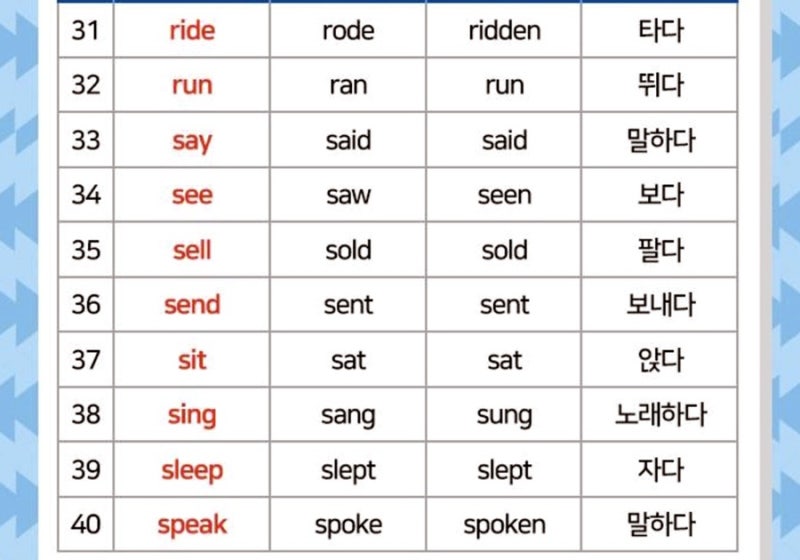
![동사의 불규칙 삼단변화, A-B-B-1. [2탄] - YouTube 동사의 불규칙 삼단변화, A-B-B-1. [2탄] - Youtube](https://i.ytimg.com/vi/lIsCC2aMkeQ/maxresdefault.jpg)

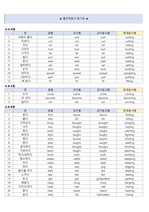
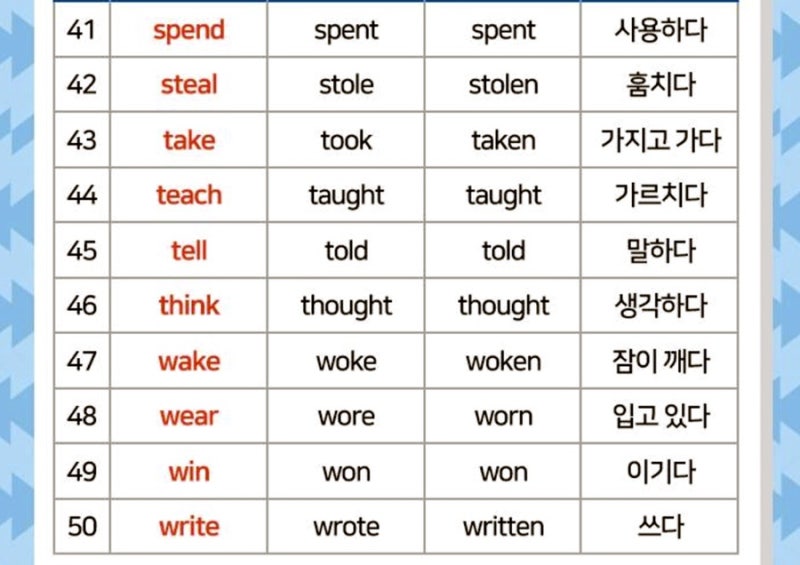

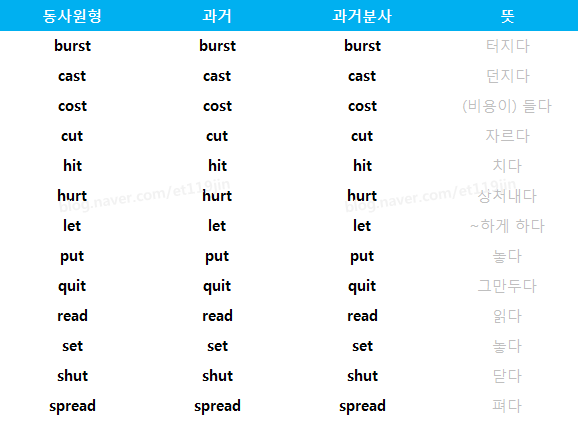



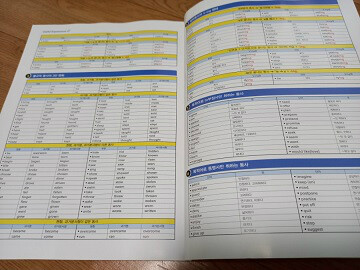
![불규칙 동사의 3단 변화] 동사 변화 (현재-과거-과거분사) 쉽게 배우기 #불교칙동사 3단변화 # 불규칙동사표 #동사3단변화 - YouTube 불규칙 동사의 3단 변화] 동사 변화 (현재-과거-과거분사) 쉽게 배우기 #불교칙동사 3단변화 # 불규칙동사표 #동사3단변화 - Youtube](https://i.ytimg.com/vi/utfjjw6OELU/maxresdefault.jpg)



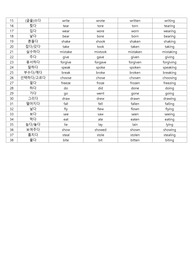

![영어 동사의 3단 변화 (규칙형) 쉽게 정리 [-ed 발음] 영어 동사의 3단 변화 (규칙형) 쉽게 정리 [-Ed 발음]](https://t1.daumcdn.net/cfile/tistory/9993FB415EB0B9B82D)
![영어 말하기 필수 동사의 3단 변화 2편 영어 단어 외우기 03강] 동사에 시간 표시하기 > Youtube 영상(대본) | 암기없는 영어 원리” style=”width:100%” title=”03강] 동사에 시간 표시하기 > YouTube 영상(대본) | 암기없는 영어 원리”><figcaption>03강] 동사에 시간 표시하기 > Youtube 영상(대본) | 암기없는 영어 원리</figcaption></figure>
<figure><img decoding=](https://i.ytimg.com/vi/C0tPuvAjYXA/mqdefault.jpg)
![불규칙동사의 3단 변화 C~E Flashcards | Quizlet 초중고 생활/교육 > 중등교육 > 중1 불규칙동사 테스트[3단변화][40단어]” style=”width:100%” title=”초중고 생활/교육 > 중등교육 > 중1 불규칙동사 테스트[3단변화][40단어]”><figcaption>초중고 생활/교육 > 중등교육 > 중1 불규칙동사 테스트[3단변화][40단어]</figcaption></figure>
<figure><img decoding=](https://previews.jisikmall.com/thumb/5072000/5072555_1_5.jpg)


![영어 동사의 3단 변화 (규칙형) 쉽게 정리 [-ed 발음] 03강] 동사에 시간 표시하기 > Youtube 영상(대본) | 암기없는 영어 원리” style=”width:100%” title=”03강] 동사에 시간 표시하기 > YouTube 영상(대본) | 암기없는 영어 원리”><figcaption>03강] 동사에 시간 표시하기 > Youtube 영상(대본) | 암기없는 영어 원리</figcaption></figure>
<figure><img decoding=](https://i.ytimg.com/vi/mpyH9BMIJ60/maxresdefault.jpg)

![알라딘: [중고] 기적의 동사 변화 트레이닝 알라딘: [중고] 기적의 동사 변화 트레이닝](https://image.aladin.co.kr/product/25808/79/letslook/K532736330_t17.jpg)

![Chapter2] PSS2-4 불규칙 변화 동사의 과거형 [중학영문법3800제 2학년] - YouTube Chapter2] Pss2-4 불규칙 변화 동사의 과거형 [중학영문법3800제 2학년] - Youtube](https://i.ytimg.com/vi/hTK9TteFmLY/maxresdefault.jpg)
![수능대비 불규칙동사 테스트[3단변화][180단어] 레포트 수능대비 불규칙동사 테스트[3단변화][180단어] 레포트](https://image4.happycampus.com/Production/thumb212/2012/10/22/data11629522-0001.jpg)
![영어 말하기 필수 동사의 3단 변화 1편 핵심 동사 41 영어 단어 외우기 03강] 동사에 시간 표시하기 > Youtube 영상(대본) | 암기없는 영어 원리” style=”width:100%” title=”03강] 동사에 시간 표시하기 > YouTube 영상(대본) | 암기없는 영어 원리”><figcaption>03강] 동사에 시간 표시하기 > Youtube 영상(대본) | 암기없는 영어 원리</figcaption></figure>
<figure><img decoding=](https://i.ytimg.com/vi/mpyH9BMIJ60/mqdefault.jpg)


![중3 영어 기본 불규칙동사 테스트 [3단변화][80단어] 시험자료 중3 영어 기본 불규칙동사 테스트 [3단변화][80단어] 시험자료](https://image4.happycampus.com/Production/thumb212/2015/06/25/data13391543-0001.jpg)


![불규칙동사 Day 2 [한글발음기호]_3단변화 - YouTube 불규칙동사 Day 2 [한글발음기호]_3단변화 - Youtube](https://i.ytimg.com/vi/Stvsq3BmmkM/maxresdefault.jpg)

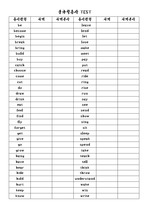

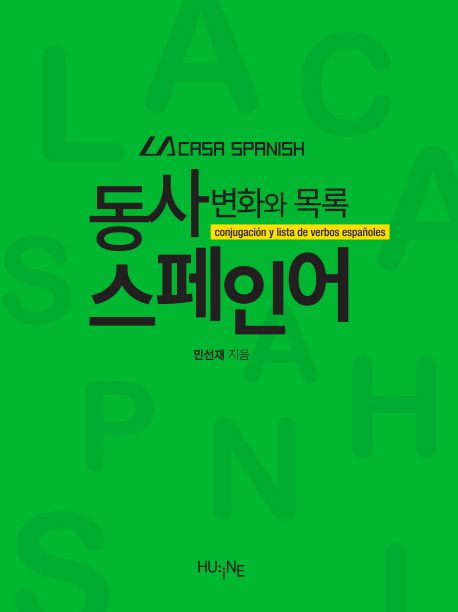
Article link: 동사 3 단 변화.
주제에 대해 자세히 알아보기 동사 3 단 변화.